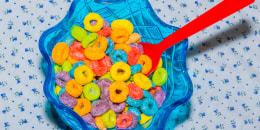A recent, first of its kind, study found that tampons contain metal, such as lead and arsenic.
“Some tampons had higher concentrations of one metal, lower concentrations of another,” Jenni A. Shearston, the lead author on the paper, previously told TODAY.com. “There wasn’t a specific tampon that we tested that seemed to have, for example, a lower concentration of all the metals.”
While this seems worrisome, Shearston wants “to caution people not to panic.”
“We just need more information,” the postdoctoral scholar at UC Berkeley School of Public Health and department of environmental science, policy and management said. “What I would like to encourage people to do is support more research and ask more questions about this to try to make research on menstrual products and menstruation a priority.”
In light of this study, some might want to use tampons less. There is a growing market of tampon alternatives, including menstrual cups, period underwear and more.
“I think also good old-fashioned pads are a good alternative that people might be a little more likely to use and have used them before and they feel comfortable. They’re easy to get for now,” Dr. Jennifer Lincoln, an OB-GYN and author of “Let’s Talk about Down There: An OB-GYN Answers all Your Burning Questions … Without Making you Feel Embarrassed for Asking,” tells TODAY.com.
Disposable tampons and pads should only be used once and not longer than instructions say. While many people experiencing period poverty or facing shortage of menstrual products might feel this is their only choice, doctors say it's not safe to reuse disposable period products.
“It’s important to use these products as directed,” Lincoln says. "Please don’t leave your products in longer … your risk of infection and skin breakdown, irritation, goes up.”
The experts share what people need to know about other period products and how to best use them — or avoid them.
Menstrual cups
Menstrual cups are funnel-shaped devices made of medical-grade silicon or latex that are inserted like tampons to collect menstrual fluid. They’re reusable and people can use just one for the entire duration of their period.
“What’s nice about them is that they actually hold more than usually a few tampon’s worth. So you don’t have to change them as frequently,” Lincoln says. “If you’ve got one, you’re good as opposed to needing a new box of tampons every single time.”
Their absorbency and reusability are both strengths of the cup.
“You can wear them up to 12 hours,” Dr. Adi Katz, an OB-GYN and director of gynecology at Lenox Hill Hospital, tells TODAY.com. “They usually have a little tab at the end to help with removal.”
But there are a few downsides. Cups can be expensive to purchase upfront, though over time they save money. And there are some reports that people who use menstrual cups “has led to higher rates of IUDs coming out or expulsion,” Lincoln says.
“We don’t know exactly why the IUDs are coming out because some people have said, ‘Well, just release the suction before your remove that cup and that should negate the effect of the suction,’” Lincoln explains. “But also it’s thought to happen because there’s suction in place while you’re wearing the cup, so is that slowly dislodging the IUD?”
People also wonder if, when removing the cup, people might be accidentally grabbing the strings to the IUD and pulling it out as well, though Katz says that can also rarely occur when people try taking out tampons. People can ask their doctor to cut their IUD string shorter to avoid that.
“The good news is that most people will only need this if they have a copper IUD because for a lot of people that have the progesterone-only IUDs, they get no periods,” Lincoln says.
People need to sterilize their cups after their periods. Lincoln says it’s done just like one sterilizes a bottle — by putting them in boiling water and allowing them to cool. During menstruation, people can rinse them with a little water and a mild soap (one without fragrance like what they use to clean their vulva, Lincoln says).
“When you’re using it during your period, you can just wash it after the use and put it back in,” Katz says.
Menstrual discs
Menstrual discs look and work a bit like contraceptive diaphragms. They’re “essentially a medical grade plastic bag with a rim,” Katz says. The circle snugs up against the cervix and captures menstrual fluid. Most of them are disposable.
“The diameter is a bit wider — you’re just folding it up and placing it up there and using your finger to get it up under the pubic bone,” Lincoln says. “It can take a little trial and error.”
Like cups, they last longer than a tampon.
“You could wear it longer because it absorbs more than a tampon,” Katz says. “You can wear it throughout the day. But you can’t reuse it.”
Lincoln suggests that people first try inserting it in a shower and using a pad or period underwear with it on heavy flow days until people feel confident with the disc placement.
“It’s actually pretty simple for most people,” Lincoln says.
Period underwear
Various companies offer period underwear, which look like normal underwear but have something in the lining that absorbs moisture and pulls it away from the body.
“They have more of an upfront cost, but over time they’re definitely cheaper, and menstrual underwear can be used as a replacement for traditional period products or used in addition to them — like if you’re worried about leaking around a cup or a tampon,” Lincoln explains. “They last a long time, so you can get your money’s worth.”
Patients often find them more tolerable than a disposable pad, for example.
“They’re a lot less irritating to the skin,” Katz says.
Like pads, period underwear comes in different absorbencies, such as light, heavy or overnight flow.
“You want to make sure that whatever you use is appropriate for the amount of bleeding you will have,” Katz says.
Reusable pads
These are cloth pads that can be washed and reused.
“It might sound a little wacky, but it’s the same concept as cloth diapers. Both of these have been around for a very long time,” Lincoln says. “It’s just important to know that ... you’re using them as directed.”
Some people might notice skin rashes or irritation. That occurs because some material used for the re-usable pads are not “as good at wicking away the moisture,” Lincoln says. If that’s the case, she recommends you simply change them more often.
Avoid sea sponges
Sponges often are just sea sponges, Lincoln says. Some people like them because they seem natural, but she urges people not to use them.
“They’re a terrible idea,” she says. “When they’ve actually looked at these under a microscope, they’ve got little bits of sand and rock and other particles, and you can’t sterilize them in the same way you can a cup or other menstrual products.”
They can cause toxic shock syndrome because the sponges have bacteria in them, as well as cuts in the vagina. If there is a cut that allows bacteria to get directly into the blood stream, that can cause serious blood infections, such as sepsis. Pieces of sponge can also become stuck in the vagina, throwing off vaginal pH, which can lead to yeast infections and bacterial vaginosis.
“Little parts can come off, which then can be retained,” Lincoln says. “That could lead to infections.”










